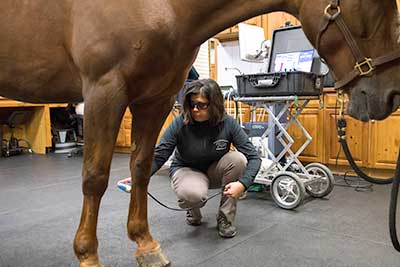Discover the Remarkable Advantages of Equine Therapy for Emotional Healing
Discover the Remarkable Advantages of Equine Therapy for Emotional Healing
Blog Article
Examining the Efficiency of Laser Therapy in Horse Therapy for Injury Rehab
The analysis of laser therapy's performance in equine injury recovery hinges on numerous factors, including recovery time, pain mitigation, and cells regrowth. Professional researches recommend notable improvements in conditions like tendonitis and osteoarthritis, attributed to boosted mobile feature and elevated ATP manufacturing. Veterinarians regularly observe remarkable end results with laser therapy compared to conventional methods, placing it as an essential aspect in equine treatment. The need for continual surveillance and personalized therapy plans can not be overemphasized. What particular professional proof sustains these insurance claims, and exactly how do veterinarians execute these protocols in practice?
Understanding Laser Therapy
Laser therapy has actually come to be an essential device in veterinary medicine, especially in the treatment of equine problems. Understood for its non-invasive nature and efficacy, laser therapy includes the application of specific wavelengths of light to stimulate tissue fixing and minimize inflammation. This restorative technique is significantly favored for its capability to accelerate the healing process in horses experiencing a variety of musculoskeletal injuries and persistent conditions.
The main system behind laser treatment is its capacity to enhance mobile functions. When laser light penetrates the skin, it is taken in by mitochondria, the powerhouse of cells, which leads to boosted production of adenosine triphosphate (ATP) This biochemical power boost assists in cellular repair work and regeneration. Furthermore, laser therapy promotes vasodilation, boosting blood circulation and oxygen shipment to damaged tissues, thus accelerating recovery.
In equine medicine, laser therapy is specifically valuable for problems such as tendonitis, osteoarthritis, and wound recovery. The technique is admired for its pain-relieving buildings, allowing horses to restore wheelchair and function a lot more rapidly. Veterinarians also value its marginal adverse effects compared to various other therapy methods, making it a reputable and secure alternative for equine care.

Exactly How Laser Treatment Functions

Upon absorption, these photons trigger a collection of biochemical modifications, enhancing mitochondrial function and leading to raised adenosine triphosphate (ATP) production. This surge in ATP increases cellular metabolic process, promoting tissue fixing and regrowth. Additionally, laser treatment regulates inflammatory reactions by affecting cytokine degrees and reducing oxidative tension, consequently relieving discomfort and swelling.
An additional substantial aspect of laser therapy is its duty in boosting microcirculation. The treatment promotes vasodilation, enhancing blood flow and oxygen image source shipment to broken tissues (Equine Therapy). This assists in the elimination of cellular particles and supports the proliferation of fibroblasts and collagen synthesis, critical for wound healing
Scientific Proof
The efficiency of laser treatment in equine therapy has been substantiated through numerous scientific studies, showcasing its therapeutic possible throughout a series of problems. A number of regulated trials and empirical research studies have documented substantial renovations in tissue fixing, pain decrease, and overall rehab timelines. A research study carried out by Turner et al. (2012) demonstrated that steeds treated with low-level laser therapy (LLLT) for ligament injuries exhibited accelerated healing compared to those getting standard treatments. The research highlighted a significant reduction in swelling and enhanced collagen development.
Likewise, study by Johnson and associates (2015) concentrated on equine muscle mass injuries, exposing that laser therapy dramatically quickened muscular tissue fiber regeneration and lowered muscular tissue tightness. These findings were affirmed by histological analyses revealing improved muscle cells company. Additionally, medical analyses have actually revealed that laser therapy can ease persistent problems such as osteoarthritis. A research by Smith et al. (2018) reported that equines with osteoarthritic joints experienced remarkable discomfort relief and boosted series of movement adhering to a regimen of laser treatment sessions.
Vet Insights

Vets likewise appreciate the flexibility of laser treatment. It can be utilized for a wide variety of conditions, from shallow injuries to much deeper musculoskeletal injuries. Dr. Emily Brown highlights its energy in treating conditions like tendonitis and osteo arthritis, where standard treatments typically fail. She mentions that laser therapy can be tailored to the particular demands of each equine, ensuring optimal end results.
Additionally, veterinarians value the capability to integrate laser therapy with other therapy techniques. This multimodal technique can enhance general therapy efficiency, supplying an extensive solution for equine rehab. Such recommendations from seasoned professionals highlight the growing approval and application of laser treatment in equine medication.
Practical Considerations
A crucial aspect of applying laser treatment in equine therapy entails recognizing the functional factors to consider that guarantee its effectiveness and safety and security. First and foremost, it is critical to choose the proper laser Continued tool, as different kinds vary in wavelength, power, and infiltration deepness. Equine Therapy. Veterinarians have to be well-versed in these parameters to customize treatment protocols properly to each injury type
Furthermore, the regularity and period of laser treatment sessions need mindful preparation to make the most of therapeutic advantages while decreasing any type of potential adverse results. Consistent surveillance of the steed's feedback to treatment can direct essential changes in the therapy program. Establishing a secure and regulated environment throughout therapies is likewise necessary to protect against unexpected exposure to laser emissions, which might harm both the horse and the trainer.
Training and qualification of employees providing laser treatment are extremely important to ensure appropriate method and to promote security requirements. Furthermore, preserving exact documents of each session, consisting of laser settings and observed outcomes, is important for reviewing the total performance of the treatment and for making data-driven choices.
Conclusion
Laser therapy has arised as an effective method in equine injury rehabilitation, supplying significant advantages in recuperation time, pain alleviation, and tissue recovery. For optimum results, continuous monitoring and individualized treatment methods stay essential in leveraging the complete possibility of laser treatment in equine care.
Report this page